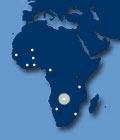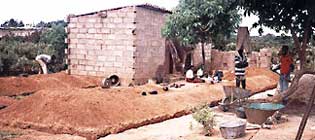|
||||||||||||
| Burkina Faso | Cameroon | Cote D’Ivoire | Ghana | Mali | Namibia | Senegal | Swaziland | Tanzania | Zambia | ||||||||||||
Information Source: Zambia: Country Assessment Report. |
||||||||||||
|
||||||||||||
|
Context Summary Zambia is approximately 753,000 square kilometers and a population of about 10 million, for a density of 13 persons per square kilometer. Most of Zambia is high plateau with a flat or gently undulating terrain. It is one of the most industrialized countries in Africa, renowned for its copper ore resources, which are processed in the country and whose export made Zambia relatively rich during the 1960s and early 1970s. Nationalization of the copper mines, years of under-investment in the mines, inexperienced management, and a fall in the world price of copper led to an economic decline beginning in the mid-1970s. Extensive borrowing has made Zambia one of the most highly indebted nations in the world relative to national output and exports. The country remains impoverished, with a per capita GDP of approximately US$410. Over 40 percent are estimated to live in urban areas. Its capital and largest city is Lusaka, with a population of almost 1.3 million, at densities of up to 1,500 persons per hectare and an average population density of approximately 150 persons per hectare. About 70 percent of Lusaka’s population live in poor, unplanned settlements comprising 20 percent of the city’s residential land. Poverty and HIV/AIDS have led to decreased urban growth rates in recent years of between 5 and 6 percent. During the copper boom that followed the country’s independence, Zambia’s cities developed quickly and spatially inefficient. Before Independence, towns were not intended to be permanent homes for the majority of the country’s workers; thus, legal tenure and the provision of housing and amenities for informal residents were not priorities. With prosperity and rapid urbanization, the republic’s new government installed sophisticated and costly urban infrastructure, confident that copper export earnings would provide for its support and maintenance. Collapse of the economy soon left the infrastructure dilapidated. The years of central planning created the development of a culture of dependence on the state and the top-down provision of services, which has resulted in citizens not expecting or wanting to pay for services enjoyed and consumed. Poverty and the lack of a sustainable housing policy have led to urban growth being absorbed into informal settlements. Many do not have the ability to pay for the level of service offered. Housing is not affordable and authorities have few resources with which to improve or maintain infrastructure and services. Lessons from Recent Projects - Summary This section summarizes the lessons by specific project. Lusaka Squatter Upgrading and Sites and Services Project
PUSH Project
George Compound Water Scheme (JICA)
Kamanga Compound Water Scheme (Irish Aid)
Chipata Community Water Project (CARE)
Pilot Project in Three Unplanned Urban Settlements (JICA)
|
||||||||||||
|
|
||||||||||||
| For more information: Click on: Foreword 1. Background 2. Current Situation 3. Policy Context and Institutional Framework 4. Upgrading Projects and Programs 5. Case Study 6. Lessons Learned 7. Challenges and Proposed Next Steps Annex A: Low Income Communities (Unplanned/Informal Settlements in Lusaka) Annex B. Improvements in 8 Unplanned Settlements- Projects and Costs Annex C. Contact Information Annex D. Key Documents Studied Annex E. Summary of Upgrading Typologies Download for Printing: |
||||||||||||
| < Return to top > | ||||||||||||
|
||||||||||||


